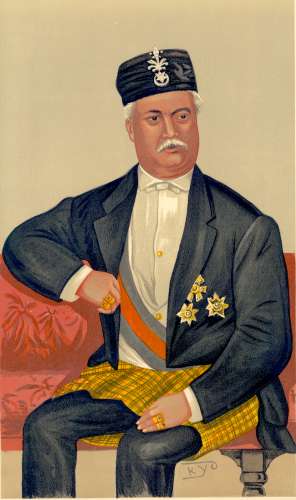Commerce and Kinship
商务与亲属关系
Revenue Farming and Later Years
包税制与晚年
Reaching the Top
达到巅峰
By the end of his life and career, the company and legacy Seah Eu Chin founded was at the farthest remove from the actual planting and trading of gambier, and firmly in the pinnacle of the “debt pyramid” as financiers. This is evidenced by the fact that in the Straits Directory of 1880, his company’s chop Chin Hin does not appear in the list of gambier and pepper merchants in town. 82 “Chinese Hong List”, Singapore and Straits Directory (1880). Meanwhile his second son Seah Liang Seah presided over the Kongkek, 83 Singapore and Straits Directory (1883), 128. which controlled prices and protected the interests of the town traders. 84 Tan Teck Soon, “Chinese Local Trade,” Straits Chinese Magazine 6, no. 23 (1902): 90. The economic network built up around the trade in gambier and pepper contained multiple relationships of interdependence: debtor-creditor between planter and shopowner, legal arrangements between kangchus and the Johore rulers, the paramilitary hierarchy of the secret societies, and merchandising agreements between kangchus and the opium farmer. 85 Trocki, “Kangchu System,” It ignored political boundaries, and was firmly hierarchical:
“Gambier represented a unified economy which blanketed the three political zones (Singapore, Riau, Johor). The economy was capitalized and controlled by a handful of wealthy taukeh in Singapore: Seah Eu Chin and his son Seah Liang Seah, Tan Seng Poh, Cheang Hong Lim, Tan Yeok Nee (Tan Hiok Nee), to name a few. Building down from them was a vast pyramid of humanity making a living out of ‘gambier’ in some way or other.” 86 Trocki, “Kangchu System,” 152.
But this was the situation as it stood after a long struggle to reach the peak of this “vast pyramid”. During his lifetime, Eu Chin witnessed the migration of the centre of cultivation and trade of gambier northwards from Riau to Singapore and then to Johore. The opening of Singapore as a free port, and the favourable free trade policy of the British (vs. the high duties levied by the Dutch on exports from Riau) made the first move an attractive one. Singapore merchants like Eu Chin also desired to control the supply of gambier, and opened plantations of their own on the island. The second move was mostly driven by the exhaustion of land in Singapore. Just as important as the lack of land to plant with gambier was the failure of the firewood supply coming from adjacent woodland, as forest cover dwindled dramatically. 87 Ridley, “Agriculture in the Malay Peninsula,” 304. By 1860, the government noticed “large tracts of land being often permitted to relapse into a state of nature….” 88 Annual Reports on the Administration of the Straits Settlements (1859/60), 16. Demand for agricultural land soon fell, while the expansion of the town drove up demand for urban plots instead. 89 Annual Reports on the Administration of the Straits Settlements (1863/64), 18. Because the Johore rulers held a favourable attitude to the Ngee Heng Kongsi and encouraged the kangchu system, the Johore plantations could develop rapidly, and thereby complete the maturation of the Singapore gambier merchants from being planters and plantation owners to the more indirect roles of financier and import-export agents. It was at this stage of development that the Kongkek was formed to regulate prices and quotas to the benefit of the town traders and merchants, as opposed to the interests of the kongsis representing the labour force, in particular the Ngee Heng. These opposing interests were the root cause of the conflict between the Ngee Heng and the town traders described previously (see Take-off and Maturity).

The Temenggong of Johore, Ibrahim, was said to be a friend of Eu Chin’s, who “used to give him valuable aid in those [1850s] troubled times.” 90 Lin, “Local Chinese Worthies,” 84. Ibrahim’s name is erroneously given as ‘Ismail’ in Lin’s article. The career of Temenggong Ibrahim followed a similar chronology as Eu Chin’s. He was the younger son of Temenggong Abdul Rahman, the de facto ruler of Singapore at the time of Sir Stamford Raffles’s landing, who died in 1825. However, Ibrahim’s elder brother was of unsound mind, and political circumstances prevented Ibrahim’s own installation as Temenggong until 1841. In the intervening years, he built up his following in the Malay community of Teluk Belanga, and worked to shore up his precarious position. It was in the mid-1830s that he managed to gain attention and status by cooperating with the British in suppressing piracy in the surrounding Straits. 91 see Trocki, Prince of Pirates, chapters 3 and 4. The period after he was finally recognized as Temenggong and gained control over the government of Johore in the 1840s coincided neatly with the push-factors driving gambier planters out of Singapore onto the riverbanks of Johore. It is not surprising, then, that he and Eu Chin would have had some sort of mutually beneficial relationship with each other. Eu Chin’s money and connections helped to finance and establish the plantations that provided revenue for the Temenggong. This contributed in no small way to the Temenggong’s accumulation of wealth and influence that finally caused him to be recognized as the legitimate ruler of Johore, over the claims of Sultan Hussain and his son, Tengku Ali. Temenggong Ibrahim died in 1862, and was succeeded by his son Abu Bakar. At this time, Seah Eu Chin was also preparing to hand over his business to the next generation.
Previous (Revenue Farming) | Back to Life | Next (Opium Farm)